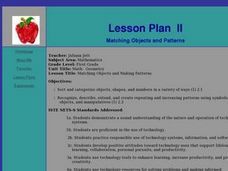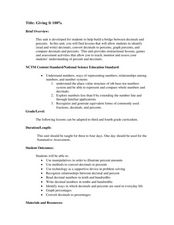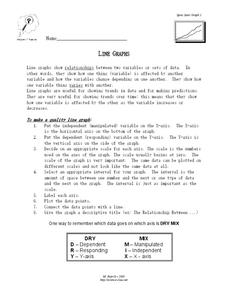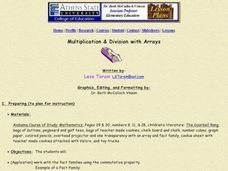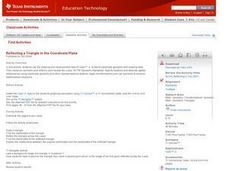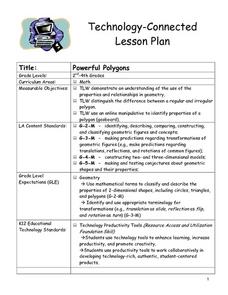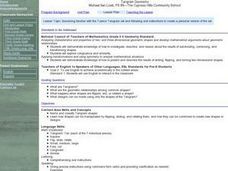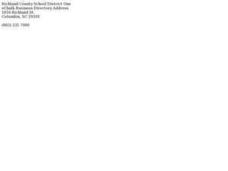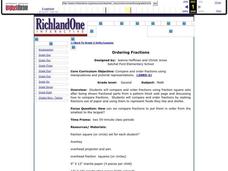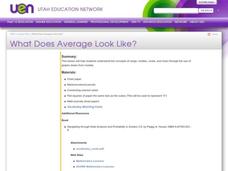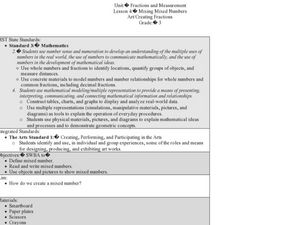Curated OER
Matching Objects and Patterns
First graders participate in hands-on activities and use objects to create patterns. They observe a PowerPoint lesson describing matching objects and patterns. In groups, 1st graders complete geometry computer activities such as planting...
Curated OER
Giving it 100%
Students build knowledge about the number relationships between decimals and percents as it relates to converting decimals into percents. In this decimal and percent lesson, students recognize equivalent forms of fractions,...
Curated OER
1, 2, 3 Hooray for Number Equivalency!
Students represent equivalent amounts using concrete materials, number symbols, and number words.
Curated OER
Line Graphs
In this algebra worksheet, learners describe the relationship between a line graph and its data. They define the reasons line graphs are used and discuss increasing and decreasing lines. There is one involved questions, requiring several...
Curated OER
To the Moon
Pupils explore circumference manipulating Moon Pie wrapper. In this geometry lesson, they manipulate snack wrappers to find circumference, diameter, radius and distance.
Curated OER
Ravishing Rings (Multiplication with a Snack)
Students understand multiplication through the use of snack manipulatives. For this multiplication lesson, students solve a multiplication problem using pretzels and then create and answer original problems. Students analyze how they got...
Curated OER
Stories That Really Add Up
Students, in groups, develop math lessons for younger students that each stems from a popular student story. Group members individually develop lessons for other subject areas based on their group's story, creating interdisciplinary units.
Curated OER
Multiplication & Division with Arrays
Third graders work with fact families using the commutative property, arrange arrays with manipulatives, and multiply and divide symbolically with numbers.
Curated OER
Reflecting a Triangle in the Coordinate Plane
Learners explore geometric concepts using technology. They manipulate the TI to find important math topics. This activity requires a TI-84 or higher.
Curated OER
Piecewise Linear Integral
Young mathematicians solve and graph piecewise functions in this calculus activity. They integrate linear functions containing restrictions and graph their answers using the TI.
Curated OER
Midsegments of a Triangle
Students analyze midsegments of triangles in this lesson plan. They use Cabri Jr. software to observe the relationships between interior angles and midsegments of triangles. Specific instructions for creating this lesson plan in Cabri...
Curated OER
Area & Perimeter
Learners define area and perimeter. They demonstrate understanding of the concepts concretely, with manipulatives, and describe with words, their strategies and thought processes.
Curated OER
Obtuse Angles
Third graders recognize and identify geometric shapes, work with manipulatives to reinforce understanding, and create polygons with various angles to display their knowledge of the different types of angles.
Texas Commission on the Arts
The Quarter Fold
Little ones identify the US quarter and explore the concept of one-fourth or one-quarter. Using real coins or coin manipulatives, they divide a square piece of paper into quarters, discuss halves and quarters, and create a design that...
Curated OER
Stirring up Fractions
Second graders practice unit fractions to identify parts of the whole and parts of a set. They utilize a variety of manipulative's including recipe boxes to get them started stirring up fractions. A multitude of books on fractions are...
Curated OER
The Dewey Decimal System -- Cataloging Collections
Students categorize their private book collections as a precursor to learning the principles of the Dewey Decimal System. They use the Internet to gain a better understanding of the Dewey Decimal System.
Curated OER
Developing the Concept Division
Young scholars use manipulatives to explain the concept of dividing multi-digit numbers.
Curated OER
Powerful Polygons
Students scan the classroom to find different common shapes. They listen as the teacher defines polygon and regular polygon. The teacher demonstrates regular polygons via the Internet and the "Math is Fun" web site. Students go outside...
Curated OER
Tangram Geometry
Students listen to a story involving Tangram pieces. Students use Tangram pieces to complete shapes using an outline of a design.
Curated OER
Motion Geometry
Second graders experiment with slides, flips and turns to understand motion geometry. In this motion geometry lesson plan, 2nd graders navigate interactive motion geometry sites. Students illustrate the results of motion...
Curated OER
Ordering Fractions
Second graders use shapes to create various fractions. In this fractions lesson plan, 2nd graders define a fraction, visit a website where they make fractions using various shapes, and use a fraction square set to create and name...
Curated OER
What Does Average Look Like?
Fifth graders explore the concepts of range, median, mode, and mean through the use of graphs drawn from models. They use manipulatives to represent data they have collected within their groups, and compare the differences between mode,...
Curated OER
Second Servings
Second graders understand the appropriate sizes for food portions. In this food groups lesson, 2nd graders create and measure a meal using correct portion sizes and correct measurements.
Curated OER
Mixing Mixed Numbers Art/Creating Fractions
Third graders explore number values by participating in class math activities. In this fractions lesson plan, 3rd graders collaborate with classmates to discuss the technique of adding mix numbers while utilizing paper plates to help...
